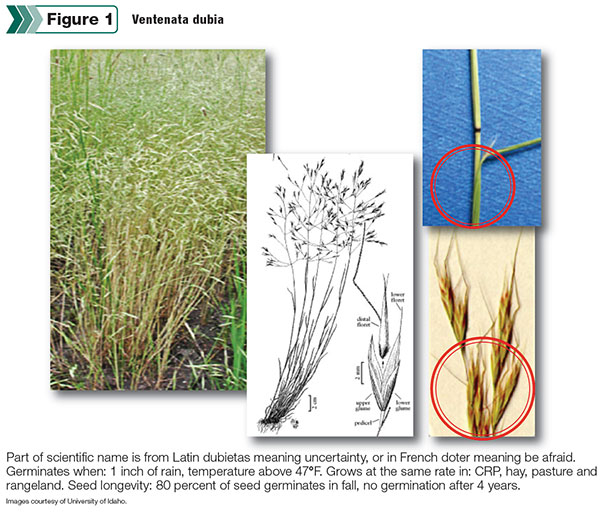Ventenata (Ventenata dubia, North Africa grass, wiregrass) is a non-native annual grass that has come to the attention of range and pasture managers.
Ventenata can be very difficult to identify at the seedling stage. As it matures, it has stiff, erect culms (stems) and leaves that are narrow.

In May and June, ventenata produces reddish-black nodes (joints in the stem) and has an unusually long ligule (1 to 8 mm; a ligule is a thin, whitish membrane that can be seen by pulling back the leaf blade from the stem).
When seeds are mature, the seeds have a twisted, bent awn (like a bristle) that are similar to oats.
Farmers report that ventenata can cause a 50 percent reduction in grass hay production both by reducing the stand life and total forage. Ventenata also eliminates the potential for foreign hay export.
In the inland Northwest, ventenata has been estimated to have caused timothy hay producers $6.7 million in losses. Additionally, Conservation Reserve Program lands have experienced a 50 percent reduction in nest success for some birds.
Although livestock nutritional values in ventenata (such as crude protein) are similar to cheatgrass in early spring, ventenata has high silica content, like medusahead.
It is shorter than cheatgrass and produces about one-third as much forage as cheatgrass. Observations suggest cattle avoid ventenata more than other annual grasses.
Like cheatgrass and medusahead, ventenata is a fall germinator. Seedlings typically emerge between early October and mid-November (later than cheatgrass).
Ventenata seems to be favored by a heavy litter layer. Preliminary studies have found that litter increases ventenata seedling emergence by 40 to 95 percent.
Plants remain dormant over the winter with high survival rates under heavy litter. Stems develop around mid-May and seed heads (called panicles) are fully developed by late June.
The good news is ventenata seeds seem to be relatively short-lived (most are viable about 18 months and all seed are gone by four years), and with an integrated pest management plan, ventenata can be controlled.
Selective herbicides can be effective at ventenata control, but label directions should be read carefully, especially in hayfields.
Because herbicides can also potentially damage desirable perennial grasses, fall application is recommended and at the lowest application rate.
Other practices that may help control ventenata are fertilizing pastures, fall or spring burning and avoiding grazing to more than 50 percent of available forage.
Expect to hear more about this weedy annual grass in the future. It is on the move into new areas it hasn’t been found in previously.
If you think you may have ventenata, but aren’t sure how to identify it, you can take a sample to your local extension or NRCS office. ![]()
Amanda Gearhart is a rangeland extension specialist with University of Idaho.
For more information:
Plant guide (PDF, 151 KB)
Ventenata control strategies found for forage producers, (PDF, 901KB)
Ventenata (PDF, 248 KB)






